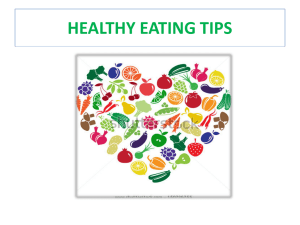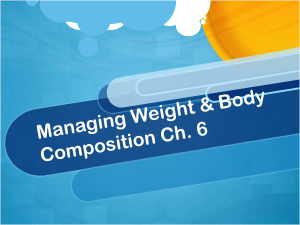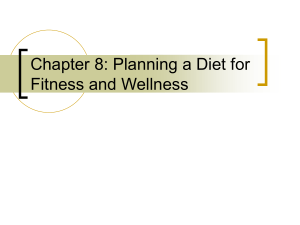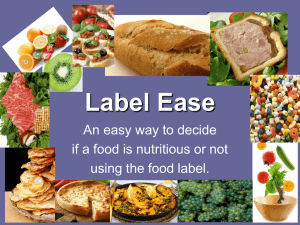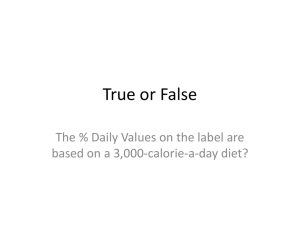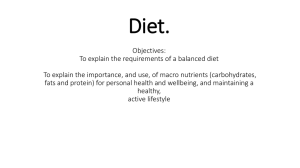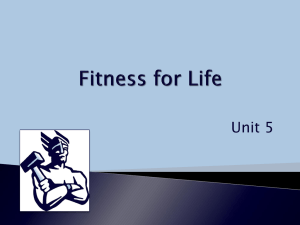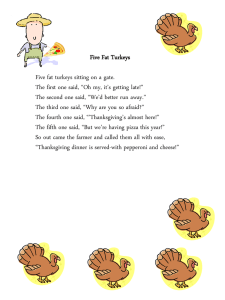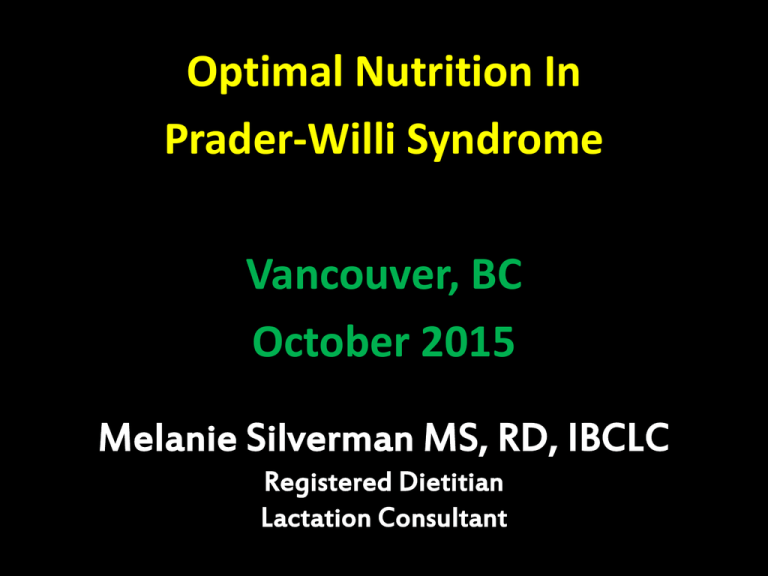
Optimal Nutrition In
Prader-Willi Syndrome
Vancouver, BC
October 2015
Melanie Silverman MS, RD, IBCLC
Registered Dietitian
Lactation Consultant
www.melaniesilverman.com
Services I Offer….
•
•
•
•
•
•
•
•
Picky Eaters
Poor Weight Gain
Overweight & Obesity
Food Allergies & Intolerances
Tube Feedings
Breastfeeding
Adult Weight Management: Intuitive Eating
Prader-Willi Syndrome
Objectives
• WHAT to feed
–
–
–
–
–
–
Nutrition 101
Ratio of carbohydrate, protein and fat
Different types of diets-Which is best?
Food labels
Supplements
Hydration
• HOW to feed
– Structure
– Rules
– Advocate
Nutrition 101
•
•
•
•
•
•
•
Calories
Carbohydrate
Protein
Fat
Vitamins
Minerals
Water
Calories
Calories=A unit of energy
(or the fuel for the body)
Where do CALORIES come from?
• Carbohydrate
• Protein
• Fat
Carbohydrates (CHO)
Protein (PRO)
Fat (Fat)
Combination Foods
Eggs: PRO, FAT
Yogurt and Milk: CHO, PRO, FAT
Nuts and seeds: PRO, FAT
Beans, Lentils: CHO, PRO, FAT
Cottage Cheese: PRO, FAT
What Do They Do?
• CHO: energy and disease protection
• PRO: repair cells and make new ones,
important for growth, muscles
• FAT: energy, soft skin, fat soluble vitamin
metabolism
Prader-Willi Food Pyramid
My Plate
PWS Plate?
WHOLE Grains
Protein
Vegetables
Fruits
DDAIRY
GOOD Carbs vs. BAD Carbs
“GOOD”
• Vegetables
• Fruits
• Whole grains (>3 grams
fiber per serving)
• Beans, Peas, Lentils
• Brown rice
• Quinoa
“BAD”
•
•
•
•
•
•
•
•
•
Candy
Cakes
Cookies
Juices
Muffins
Ice Cream
Donuts
Low fiber crackers
WHITE bread, pasta, rice
Calorie Percentages
• EXAMPLE: 1000 calories per day
• Certain PERCENTAGE of those calories are
carbohydrate, protein and fat.
Current Calorie Percentages In
America
CARBS: 50-70%
PRO: 15-20%
FAT:
30-35%
PWS Research Study
“A reduced energy intake, well balanced diet
improves weight control in children
with Prader-Willi Syndrome”
J.L. Miller, C.H. Lynn, J. Shuster, D.J. Driscoll, 2012
•
•
•
•
Children ages 2-10
45% carbohydrate, 25% protein, 30% fat
20 grams of fiber
CALORIE CONTROLLED
PWS Research Study
CARBS: 45% (less carbs)
PRO: 25% (more protein)
FAT: 30% (same fat)
FIBER: 20 grams per day
*Miller, et al. A reduced-energy intake, well balanced diet improves weight control in
children with Prader-Willi syndrome, J Hum Nutr Diet, 2012
Comparison
USDA
PWS Study
CARBS: 50-70%
PRO: 15-20%
FAT:
30-35%
CARBS: 45%
PRO: 25%
FAT: 30%
FIBER: 20 grams
per day
Results
IMPROVES weight and body
composition in children with
PWS compared to a
simple energy restricted diet
(low fat, high carb)
Low Carb Diets
Low Carb is the trend…but how low do we go?
Low Carb Diets
Low Carb is the trend…but how low do we go?
Not sure
“Diets Discussed on Facebook”
• Ketogenic
• Modified Adkins Diet (MAD)
• Paleo Diet
Ketogenic Diet (KD)
• Around since 1920’s for epilepsy (seizures)
• Mimics starvation Usually carbohydrates
for used for energy.
• KD forces fat use because there is limited CHO
Epilepsy foundation
Ketogenic Diet (KD)
• 80% FAT diet…the rest carbohydrate and
protein. (4 times as much fat as protein and
carbohydrates)
• Calorie restriction (weight and measure
everything to grams)
Epilepsy foundation
Ketogenic Diet (KD)
Seizure Relief Results:
• 1/3 become seizure free, 1/3 have reduction in seizures
and 1/3 don’t succeed because it is too hard
• Stay on diet for 2 years and then slowly wean off
• Multidisciplinary team monitoring is essential with
frequent physician visits, anthropometric measures,
blood draws, and urine analysis.
Epilepsy foundation
Risks/Problems with Ketogenic Diet
•
•
•
•
•
•
•
Dehydration
Constipation
Kidney stones/gall stones
Pancreatitis
Decreased bone density
Vitamin/mineral deficiencies
Slowed growth or weight gain
Source: Epilepsy Foundation
Modified Atkins Diet (MAD)
• Modification of traditional ketogenic diet
• No need to weigh/measure food
• No fluid or calorie restriction
Modified Atkins Diet (MAD)
• Fats encouraged and no restriction on protein
• Carbs are monitored closely
• 10-20 grams of CHO per day
One slice of bread is 15 grams of CHO
MAD Diet
• Heavy in meats, chicken, fish, turkey, eggs,
cheese, oils, avocado, butter, cream
• Carbohydrates limited to 1 serving per day
• AVOID…Starchy vegetables (corn, dried beans,
peas, potatoes), breads, crackers, cakes,
cookies, juices, cereals, & rice
MAD Diet
• PROBLEMS: lack of variety, very high in fat,
no long term research on health risks
• This diet is easier than traditional Ketogenic
diet for seizure control
Paleo Diet
• NO: grains, beans, dairy, vegetable oils, sugar,
high fructose corn syrup, artificial sweeteners and
highly processed foods
• Meat from animals the “way nature intended”
(cattle fed on grass)
• Fruits & vegetables (but more vegetables)
• Avocado and coconut oil
• Nuts ,in moderation
Paleo Diet
• Advantages: “Real food”
• Disadvantages:
– lack of variety
– cost
– adherence
– no documented long term research
Risks Of Low Carb Diets in PWS?
• New Thought: Fat is good for the body
• Between 0 and 45% CHO per day, we don’t know.
(0% is not the answer)
• Prolonged ketosis + Growth hormone=???
• Complications: clinically, in kids up to 3, we have
seen low energy and poor weight gain
What Do I Do?
• Be careful and cautious
• Ask questions
Work with medical professionals who are
knowledgeable and tell them
everything you are doing
Mayoclinic.org
~45% CHO, 25% PRO, 30% FAT
~1000 calories per day~
• BKFST: ½ c. oatmeal, 1 Tbsp. pecans, ½ c. apples, ½ c.
enriched almond milk
• SNACK: 4 oz. Greek yogurt, ½ c. strawberries
• LUNCH: ½ c. beans, 1/3 c. quinoa, 1 plum tomato, ½ c.
blackberries
• SNACK: ½ c. pears, 2 whole wheat crackers, ¼ oz.
peanuts
• DINNER: 3 oz. grilled chicken, 4 oz. roasted asparagus,
1/3 c. brown rice, cucumbers, ½ c. watermelon
Following a lower
carbohydrate diet?
Calories still count
Meal Makeovers
Before
After
• “Flakey Flakes”, Milk, Grapes
• Oatmeal, Pecans and Raisins
• Tuna Sandwich, Pretzels, Apple
• Tuna Salad on Cucumber
Slices, Apple
• Spaghetti, Salad and Garlic
Bread
• Chicken Noodle Soup with
Bread sticks, Salad
• Eggplant Lasagna (roasted
eggplant as noodles), berries
• Fish, Asparagus, Salad
Meal Makeovers
Before
• Tacos with Hard Shells
• Pasta and Cream Sauce
After
• Turkey Taco salad (no shell)
• Spaghetti SQUASH and tomato
sauce
• ½ Plain Bagel and Cream
Cheese
• 1 Slice Whole Wheat/Sprouted
Toast with Peanut Butter
• Buttermilk Pancakes, Eggs,
Bacon
• Whole Wheat Waffle, Egg,
Bacon
Meal Makeovers
Before
• Fish, Broccoli, Cornbread,
Pears
After
• Fish, Broccoli and Brown
rice
• Cheese Sandwich and Chips
• Cheese, Fruit, Veggie, Olive
Plate
• Pita Bread with Egg Salad,
Whole Wheat Pretzels and
Fruit
• Egg Salad in Lettuce and
Fruit
• Soup in a bread bowl
• Soup and Salad
Calorie Calculations
• Children and adolescents vary:
– 10-11 calories per centimeter to maintain growth
velocity
– 8-9 calories per centimeter for slow weight loss or
support linear growth
• Adults vary:
– 1,000-1,200 per calories day (more or less)
– About 60% of a typical person’s diet
ADA Pediatric Nutrition Assessment, 2008
Look at Fiber First….
FDA-Consumer
Updates
Hydration
•
•
•
•
Lemons/limes/oranges
Cucumber & mint (grow your own herbs)
Cinnamon sticks/apples
$$$ Flavored waters (Hint, Hint Fizz, Metromint)-read
labels
Artificial Sweeteners
Sucralose, Acesulfame K, Saccharin, Neotame,
Nutrasweet
Should I use them?
Are they safe?
Artificial Sweeteners
ANSWER 1: I would prefer if you didn’t
ANSWER 2: I am not sure
*Stevia may be OK…use sparingly.
Supplements
• Fish Oil = brain and eye development (after 1 year)
• Carnitine = alertness, hypotonia
• Coenzyme Q10 = energy
More Supplements
• Multivitamins: some may need if diet
restricted
• Iron: Using it without iron deficiency can be
dangerous
• Vitamin D: Check levels
• Vitamin B 12: May improve energy
• Probiotics: GI issues (exciting field of research)
Best Food Sources of Supplements
• Carnitine: beef, milk
• CoQ10: salmon, tuna, liver, whole grains
• Omega 3’s: fish, walnuts, spinach
• Vitamin D: salmon, egg yolk, fortified milk
and cereal
• Probiotics: yogurt, kefir
Supplements in PWS
DISCUSS WITH PHYSICIAN
How To Feed
Structure
Essential
Structure: MENUS
• B, S, L, S, D
• Separate by at
least 2 ½ hours
• Post menus
Menu Planning
• Eatingwell.com
• Emeals.com
Structure: RULES
•
•
•
•
•
Post rules
Family meals
No distractions
Eat at the table
Manners
“This Is Just What We Do”
Routines
Rules
Boundaries
Consistency
Balance
PROVIDES:
Safety and
Security
The Kitchen Table
• The most important piece of furniture you
own
• Strengthens:
– Familysense of support
– Vocabulary
– Manners
– Helps with some picky eaters
Helpful Hints in Feeding with PWS
•
•
•
•
•
Plate the food. No family style at the table.
Use smaller plates
Never use food as incentive or reward
Limit buffets or open access to food
Consider using portioned containers
Principles of Food Security in PWS
• No doubt when meals will occur and what foods
will be served— MENU/RULES
• No hope of getting anything different from what
is planned—MENU/RULES
• No disappointment related to false expectations-MENU/RULES
Linda Gourash, MD & Janice Forster, MD
Ways to Achieve Food Security
1. Secure food accessibility by locking
refrigerator/cabinets
2. Avoid spontaneity related to food
3. Supervise food exposure
4. Post the meal schedule/menus
5. Try to avoid places and social situations with
excess food
Janice L. Foster, MD and Linda M. Gourash, MD Pittsburgh Partnership
Physical Activity
•
•
•
•
•
Parks
Hikes (localhikes.com)
Gymnastics
Tae Kwon Do
Rigorous Sports
Family Participation
Physical Activity
ESSENTIAL
For all of us…
Be The Advocate:
Schools/Camps/Residences
• Educate teachers, counselors, staff, physicians,
aids, pediatricians and other medical
professionals
• Provide literature
• Picture of son/daughter with diagnosis, what
it means, emergency contact numbers (food
allergic patients do same)
Soccer Snack Letter
Dear Editor:
Youth soccer season is in full force. Along with shin guards
and shiny uniforms our kids are getting snacks and plenty of
them. If the snacks were fresh fruit and water, I wouldn't be
complaining. Parents are complaining to me all over the
country about other parents who are bringing cupcakes,
candy, donuts, brownies, chips and sugar laden
juices. Pumping our kids full of sugar after soccer is a
physiologic mistake and sends the wrong message to our kids
about taking care of their bodies post exercise. If snacks are
to continue, all leagues should set a "fresh fruit and bring your
own water policy" to stop our kids from refueling with loads
of sugar. Would you eat a cupcake after your 5 mile run? I
doubt it. Then why are we feeding our kids this way?
The Huffington Post:
Dear School Principals
…I am asking you to make two simple changes. First, set a noncaloric birthday celebration policy. Stickers, books and creative
art projects can be just as celebratory as cupcakes, cookies and
candy. In honor of student birthdays, ask them to donate their
favorite book to the school library or gather input from all
students in the classroom on a charitable donation in honor of
birthdays. Second, you must ban food incentives for correct
answers. Correct answers should add to a child's self-esteem, not
their waistline.
Advice
•
•
•
•
•
•
•
•
•
•
•
•
Structure meals/snack times
Plan meals
Balance of CHO, PRO, FAT
Cook meals with fresh foods
Visit Farmer’s Markets
Shop the perimeter of the grocery store
Read food labels closely
Limit sugar intake
No juice, soda, sport drinks, etc.
Supplementsask physicians
Intensive, frequent physical activity
Be an advocate
Follow Me…
FeedPhilosophy
Feeding
Philosophies
Thank you!
EMAIL: melanie@melaniesilverman.com
OFFICE: 949.607.8248
Melanie R. Silverman MS, RD, IBCLC


